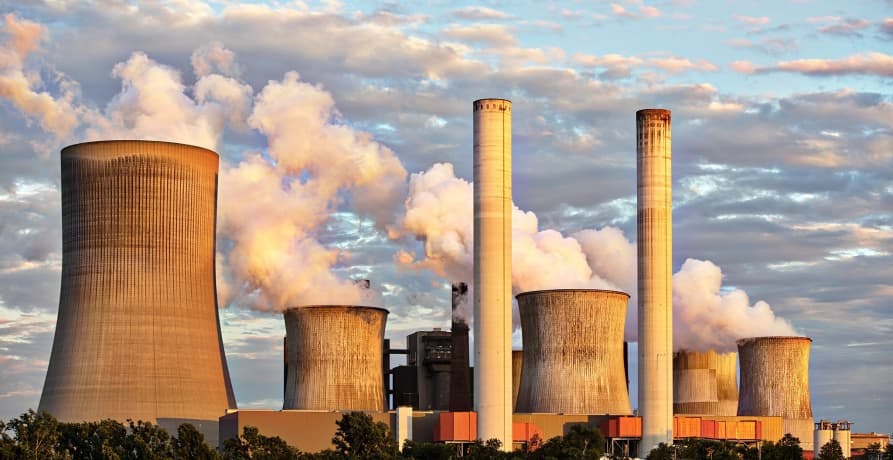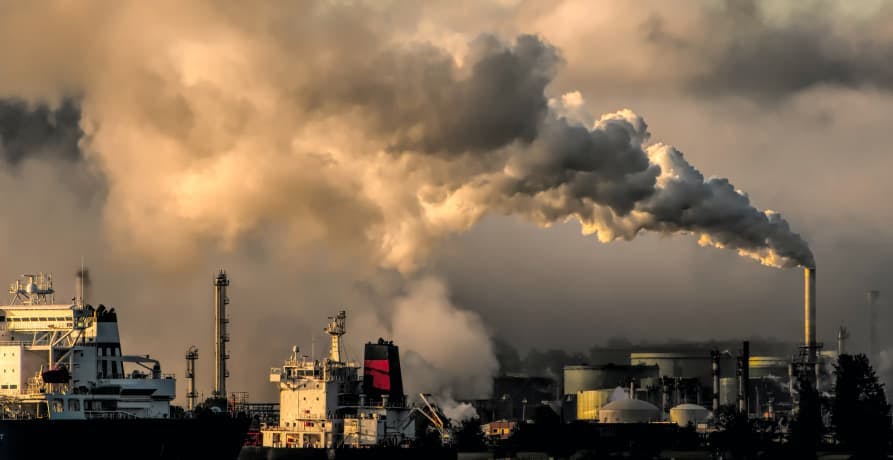ESG / CSR
Industries
Greenhouse gases by sector: who is polluting the most?



Certain sectors contribute to carbon emissions more significantly than others. Identifying and understanding these high-emission sectors is crucial for prioritising targeted actions to mitigate their harmful effects on the climate.
Analysing the latest greenhouse gas data per sector not only sheds light on the primary sources of pollution but also guides policy-making, business strategies, and public awareness initiatives. This information helps to focus efforts on areas where interventions can make the most substantial difference, aligning with broader goals of environmental responsibility and sustainable development.
👉 In this article we'll take a closer look at the detailed breakdown of greenhouse gases data per sector. We'll explore the actions that both individuals and companies can take to help reduce emissions across these sectors.
Greenhouse gases
Greenhouse gases (GHGs) play a crucial role in warming the planet by trapping heat in the atmosphere, contributing to a rise in the average global temperatures and exacerbating the climate crisis. This warming effect comes from various sources, including industrial activities such as burning fossil fuels and land-based actions like deforestation.
However, it's essential to recognise that not all GHGs are created equal. Each gas contributes to atmospheric heating at a different rate, and the heating effect is often expressed relative to carbon dioxide (CO2), the most common type of GHG. Scientists quantify the global warming potential of different greenhouse gases in terms of equivalent metric tons of CO2, enabling comparisons across different gases.
Furthermore, the planet's natural sinks, such as forests and oceans, can absorb GHG emissions. The challenge we currently face is that human activities are emitting more GHGs than these natural sinks can absorb, exacerbating the problem of global warming.
Another critical aspect of understanding GHGs is their varying lifespans in the atmosphere. While CO2 can linger for centuries, contributing to long-term climate change, other gases like methane (CH4) have a shorter atmospheric life but are more potent in their warming effect. This complexity in the nature and impact of different GHGs underscores the importance of a nuanced approach to climate mitigation strategies, recognising that tackling this challenge requires understanding and addressing the unique characteristics and sources of various greenhouse gases.
The most common types of greenhouse gases that are measured by the Environmental Protection Agency in the US (EPA) are:
Carbon dioxide (CO2)
Primarily produced from the combustion of fossil fuels such as coal, oil, and natural gas, CO2 plays a significant role in supplying energy to our modern infrastructure. This includes fuelling transportation, manufacturing processes, electricity and heat production, and construction activities like building roads, bridges, and skyscrapers.
However, CO2 emissions also originate from other sources. For example, clearing forests for agriculture or suburban development releases CO2 stored in the soil and dense plant matter (biomass) of forests, exacerbating the overall emissions.
Methane (CH4)
Methane, a highly potent greenhouse gas, can heat the atmosphere up to 80 times faster than CO2. Methane emitted into the atmosphere primarily results from the production and combustion of natural gas, which typically consists of 70-90% methane. Additionally, biological and land-based sources such as livestock farming, food waste, and biomass burning contribute significantly to methane emissions, highlighting the need for comprehensive mitigation strategies.
Nitrous oxide (N2O)
Similar to CO2, N2O can persist in the atmosphere for extended periods, accumulating over time to contribute to global warming. Agriculture, particularly the use of synthetic fertilisers, is a major source of nitrous oxide emissions. These fertilisers not only release N2O into the atmosphere, but their runoff can also lead to harmful algal blooms that harm coastal marine life. Other sources of N2O emissions include fossil fuel combustion and vehicle exhaust, emphasising the need for cleaner energy and transport solutions.
Fluorinated gases (F-gases)
Despite their relatively small quantity, F-gases are incredibly potent, with some variants exerting a warming effect thousands of times greater than CO2. One class of F-gases, Hydrofluorocarbons (HFCs), was initially introduced as a solution to ozone layer depletion caused by Chlorofluorocarbons (CFCs). However, this remedy introduced a new challenge, as HFCs are powerful greenhouse gases. Recognising this unintended consequence, regulations such as the Kigali Amendment to the Montreal Protocol, have been introduced to replace HFCs in new products, reflecting the complex nature of environmental challenges and the need for thorough solutions that consider potential side effects.

CO2 emissions: global trends
Globally, the five countries contributing the most to greenhouse gas emissions are China (33%), the United States (13%), India (7%), Russia (5%), and Japan (3%). Collectively, these nations account for over 60% of total greenhouse gas emissions.
❗️ In 2021, nearly half of the global energy-related carbon dioxide emissions were attributed to the top 10% of emitters, while the bottom 10% were responsible for only 0.2% of global emissions.
China, the world's largest emitter, heavily relies on coal in its manufacturing processes. A significant portion of China's products are destined for export, meaning that global consumption of Chinese goods indirectly fuels the country's dependence on fossil fuels. Additionally, China's growing transportation sector relies on imported oil, further contributing to its emissions profile.
In contrast, in the United States emissions largely stem from its transportation, industry, and energy sectors. As a significant producer of crude oil, the U.S. not only consumes but also exports oil globally, playing a major role in the international energy landscape.
India's GHG emissions profile reflects its rapid industrialisation and reliance on coal as an accessible and inexpensive energy source. In 2020, coal accounted for 75% of India's electricity generation and remains the primary energy source for the industrial sector. This reliance on coal emphasises the challenges that emerging economies may face in balancing development goals with environmental responsibilities.
Historical emissions
Historical emissions hold significant relevance in the assessment of global warming, as most greenhouse gases (GHGs) persist in the atmosphere for extended periods. Unlike temporary pollutants, these emissions accumulate over time, magnifying their impact. When evaluating both land and fossil fuel-based emissions, the top historical contributors are the US, China, Russia, Brazil, and Indonesia.
Land-based emissions
The examination of land-based emissions in particular underscores the urgency of halting deforestation and implementing strategies to restore and conserve both forested and oceanic ecosystems. For countries like Brazil and Indonesia, the situation is nuanced. Although they have relatively low fossil fuel emissions, extensive deforestation within their rich, biodiverse rainforests has led to the massive release of CO2 into the atmosphere.
This pattern emphasises that climate change isn't solely a product of industrial activity and energy consumption. It also results from changes to the natural environment, such as deforestation and degradation of other vital carbon sinks. Consequently, a holistic approach to emission reduction must recognise and address these different sources of emissions, including responsible land management and the preservation of natural habitats. Such an approach not only mitigates climate change but also protects biodiversity and the natural world.

UK emissions
According to the Carbon Brief's analysis, in 2023, the United Kingdom achieved a significant milestone in its efforts to combat climate change, with greenhouse gas emissions dropping by 5.7% to their lowest level since 1879. This reduction, down to 383 million tonnes of carbon dioxide equivalent (MtCO2e), marks a pivotal moment historically and reflects a 53% decrease from 1990 levels, even as the economy has grown by 82% over the same period.
The decline in emissions was primarily driven by a notable 11% decrease in gas demand, supported by increased electricity imports and milder weather conditions. Additionally, the closure of nearly all coal-fired power stations contributed to a 23% reduction in coal use, marking its lowest levels since the 1730s.
Despite these advancements, challenges remain, particularly in sectors like transport and buildings, which continue to be significant contributors to emissions. Achieving the UK's ambitious net-zero target by 2050 will necessitate a continued focus on reducing emissions from these sectors through enhanced policy measures and technological innovations.

Global emissions
According to the IEA, global energy-related CO2 emissions rose by 0.9% in 2022 and 1.1% in 2023, reaching a new high of 37.4 billion tonnes. The majority of this increase - amounting to 410 million tonnes (Mt) - can be attributed to emissions from the coal sector (65%).
However, the IEA notes in its report that without the upscaling of key clean energy technology such as solar PV, wind, nuclear, heat pumps, and electric cars (EVs), the growth of emissions between 2019 and 2023, would have been three times higher than the reported 900 Mt increase.
Another positive point to note is that advanced economy GDP grew by 1.7%, while per capita emissions fell by 4.5%. This can be attributed to a mix of structural and cyclical factors, including strong renewables deployment and coal-to-gas switching in the United States. Additionally, weaker industrial production in some countries and milder weather also played a role in this trend, showcasing a decoupling of economic growth from emissions by sector.
Although the increase in renewable energy is positive, the continued growth trajectory of emissions calls for urgent, stronger actions to accelerate the clean energy transition and align with global energy and climate goals.
👉 To learn more about the Paris Agreement and the commitments made by countries around the world, check out our article.

Biggest CO2 emitters by industry
The unrelenting rise of global greenhouse gas (GHG) emissions throughout the past century has become a major concern within the international scientific community, prompting urgent calls for immediate action. The consequences of global warming, driven by this relentless increase in emissions, extend far beyond just a temperature rise. The situation is triggering cascading effects ranging from the mass extinction of species and disruptions to ecosystems to exacerbating social inequalities and economic disparities across the globe.
Our daily choices, whether it's the mode of transportation we choose, the food we consume, the way we shop, or how we heat our homes, collectively contribute to this mounting crisis. These seemingly mundane decisions have an enormous cumulative impact on the planet's health.
The good news? Each of us has the power to make a difference. By embracing more sustainable practices and lowering our carbon emissions, we can effect positive change. This not only promises to mitigate environmental degradation but will also foster cleaner air and healthier lives for current and future generations.
To effectively combat climate change and address emissions by sector, a comprehensive overhaul of key industries is essential. Here are some critical sectors that require urgent attention and revision to limit their environmental impact:


Transportation sector
Roughly one-fifth (20.2%) of global greenhouse gas emissions are attributed to the transportation sector, encompassing the vast network of cars, trucks, ships, trains, and planes that rely on fossil fuels.
Between 1990 and 2022, transport emissions have expanded at an annual rate of 1.7%, a growth rivalled only by the industrial sector. However, this trajectory was briefly altered during the COVID-19 pandemic when lockdowns and travel restrictions resulted in significant reductions in emissions. Aviation emissions plummeted by 75%, while surface transport decreased by 50%.
With the easing of lockdowns in 2020, the transportation sector rebounded. In 2022 alone, transport-related CO2 emissions surged by 3% compared to the previous year, signalling a return to the growth of emissions within the sector.
The majority of emissions linked to transportation stem from the road transport sector. Passenger cars produce the most emissions, accounting for 39%, followed by medium and heavy trucks at 23%. Despite perceptions, aviation is responsible for a more modest 9% of the sector's greenhouse gas emissions.
The persistent challenge is that nearly 80% of cars and vans on the road are powered by internal combustion engines. The International Energy Agency asserts that to align with the Net Zero Emissions by 2050 Scenario, there must be a decisive shift: all car and van sales need to be zero-emission vehicles by 2035. This highlights the pressing need for innovative policies, infrastructure development, and consumer incentives to drive a more sustainable transportation future.
What can you do?
Given the significant impact of transportation on the environment, a good first step is to evaluate your own vehicle usage and to consider how you can cut down on the resulting emissions. There are several ways to contribute to a greener future:
- Embrace alternative modes of transport - Biking, walking, or using public transportation are not only healthy alternatives but can substantially reduce your carbon footprint.
- Invest in sustainable vehicle options - If driving is essential for you, consider purchasing an electric vehicle (EV) or a hybrid car. These innovative options can significantly cut down on vehicle emissions, aligning with a more environmentally responsible lifestyle.
- Explore car-sharing and ride-sharing - Services that allow you to share rides with others or rent a car only when needed can be both cost-effective and environmentally friendly.
- Adopt efficient driving practices - Even without changing your vehicle, you can reduce emissions by driving efficiently. This includes maintaining a steady speed, keeping your vehicle well-maintained, and planning trips efficiently to minimise unnecessary driving.
By consciously choosing to adjust your travel habits, you can play a part in reducing emissions across the transport sector.
Electricity sector
The global electricity sector stands at the forefront of decarbonisation, even as electricity demand continues to rise. According to the IEA, in 2023, global renewable capacity additions increased by 50%, reaching a total of 540 gigawatts (GW). This can largely be attributed to the growth of solar and wind farms in Europe, the United States, Brazil, and China. China, in particular, has seen a phenomenal acceleration in this sector with solar PV capacity expanding by 116%, and wind farm capacity increasing by 66%. Together with other clean sources like nuclear, renewables made up over 30% of the global electricity supply - a new record high.
Despite this progress, there were challenges. Clean electricity sources like nuclear and hydro witnessed a decline for the first time since 2011. Power sector emissions also increased by 1.1%, marking an all-time high. The majority of this increase (70%) can be attributed to the coal sector, which has seen a growth of around 900 Mt since 2019.
It's worth noting that recent global events, such as the ongoing war in Ukraine, have significantly impacted the global energy supply. This event in particular led many governments to reevaluate their energy strategies due to rising fossil fuel prices and security concerns. It also spurred a push towards electrification, with increased adoption of heat pumps, electric vehicles, and electrolysers, promising future reductions in emissions. While electricity is becoming cleaner, the pressure is mounting to build more clean power capacity quickly, reflecting the complexities of this global transition.
What can you do?
Switching to energy-efficient options can make a big difference in your electricity consumption. By simply replacing standard bulbs with LEDs and upgrading to energy-efficient appliances, you can cut down on both costs and emissions.
Investing in renewable energy development is another powerful way to combat climate change. The IPCC highlights that a significant increase in investment in clean energy is required to meet global goals. Whether it's through personal investment in renewable projects or choosing a green energy plan from your provider, these changes can have a lasting impact on our planet's health.
Industrial sector
The industrial sector, which largely relies on fossil fuels - particularly coal - contributed a quarter of global energy-related CO2 emissions in 2022, totalling 9.0 Gt. Despite a modest decline due to decreased activity in China's industrial sector and the global energy crisis, this figure still fails to align with the Net Zero Emissions by 2050 (NZE) Scenario, which requires that emissions drop to about 7 Gt CO2 by 2030.
The industry's emissions have soared by 70% since 2000 due to a surge in global demand for goods. This trend highlights the critical need for understanding how to sustainably produce, use, and dispose of essential commodities.
Decarbonising the industrial sector is challenging as low-carbon technologies are either under development or expensive, and industrial assets are long-lasting and rarely replaced. To align with the net-zero emissions scenario, we need aggressive government policies that mandate CO2 emissions reductions and facilitate new technologies.
Progress will require a mix of enhanced material and energy efficiency, wider adoption of low-carbon fuels, and accelerated development of near-zero-emission production processes. This includes carbon capture, utilisation, and storage (CCUS), and hydrogen technologies.
Government policy has a pivotal role in driving this progress by reducing risks associated with new technologies and enforcing mandatory CO2 emission reduction policies.
What can you do?
Reducing consumption inherently diminishes the need for production. A significant way to lessen emissions within the industrial sector is through more conscious consumer choices, particularly by purchasing fewer goods overall.
Companies embracing the products-as-a-service models (X-aaS) are paving the way for sustainability. By providing services rather than physical goods, they can substantially decrease the necessity for manufacturing items for individual use.
Moreover, strategies aimed at extending the lifespan of products offer another pathway to curbing industrial production. By designing products to be more easily repaired, reused, and recycled, we can cultivate a more sustainable future. Putting an end to the practice of "planned obsolescence" - the deliberate design of items for rapid replacement - further contributes to this goal. Such approaches not only minimise waste but also promote a culture of longevity.

Building sector
The buildings sector is responsible for over a third of global energy consumption and emissions. This encompasses the energy used in the construction, heating, cooling, and lighting of residential and commercial spaces, as well as the appliances and equipment contained within. In 2022, operations of buildings accounted for 30% of global final energy consumption and 26% of global energy-related emissions (8% direct and 18% indirect). Notably, direct emissions decreased in 2022 compared to the previous year, even as energy use in the buildings sector rose by around 1%.
Global floor area is expanding swiftly, especially in developing countries. Increased affluence is leading to a surge in purchases of appliances like air conditioners. Given the long lifespan of structures, heating and cooling systems, and various appliances, decisions made today in design and procurement will shape energy use for many years to come. This is particularly crucial as extreme temperatures are driving up heating-related emissions in certain regions.
While current technologies offer promise for significant energy and cost reductions, the urgency for more robust policy support remains. Measures such as minimum performance standards and building energy codes are instrumental in steering the building sector towards the ambitious goal of the Net Zero Emissions by 2050 Scenario.
The good news is that many countries are recognising and responding to the urgency of the situation by widening the scope and enhancing the stringency of performance standards and building energy codes. Simultaneously, the adoption of efficient and renewable building technologies is picking up pace. Yet, the road to the Net Zero Emissions by 2050 (NZE) Scenario demands quicker, more substantial changes. This critical decade sets the stage for realising ambitious targets, such as ensuring all new buildings and 20% of existing structures are zero-carbon-ready by 2030.
What can you do?
Instead of relying on natural gas to heat your home or business, consider installing a heat pump - a more energy-efficient alternative that can drastically reduce energy consumption. Heat pumps offer the dual functionality of both cooling and heating from a single unit, making them a versatile and economical option for temperature control.
Switching from natural gas stove tops to electrical induction burner units is another smart energy-saving decision you can make in your home or business. Induction burners are known for their rapid heating and precise temperature control. They use electromagnetic fields to generate heat directly in the cookware, reducing energy loss and resulting in faster, more efficient cooking.
By investing in these modern alternatives, you can not only contribute to a more sustainable environment but also enjoy enhanced comfort and functionality in your living or working space.
Agriculture Sector
Agriculture grapples with a unique challenge when it comes to climate change. On one hand, it's extremely susceptible due to its weather dependence, yet on the other hand, it's a significant contributor to greenhouse gas (GHG) emissions, both directly through on-farm production and indirectly via land use changes due to agricultural expansion. In total, agriculture, forestry, and other land use account for roughly 23% of global GHG emissions, and most direct emissions can be attributed to methane and nitrous oxide.
Nevertheless, agriculture has the potential to reduce both direct and indirect emissions and remove CO2 from the atmosphere through carbon sequestration in biomass and soils. These strategies, when coupled with practices such as the installation of manure management systems, and climate-smart farming methods, can help agriculture combat climate change while ensuring food security and maintaining producer livelihoods.
Yet, despite this potential, agriculture trails other sectors in terms of climate change commitments and actions. It's clear that more concerted efforts are needed to tap into this sector's vast potential for a positive impact on our planet's climate.
What can you do?
Adopting a vegan or even a low-meat diet can have an enormous positive impact on the environment. The shift away from animal products reduces the demand for resources like water and feed, and minimises methane emissions, a potent greenhouse gas released from livestock. This dietary change not only aligns with ethical considerations but significantly reduces your carbon footprint.
In addition to dietary adjustments, supporting local farmers who engage in regenerative farming practices offers another pathway to environmental stewardship. Regenerative agriculture focuses on improving soil health, enhancing biodiversity, and restoring ecosystem balance. By buying produce and food from these farmers, you're encouraging practices that naturally sequester carbon, thus aiding in the reduction of CO2 emissions.
Beyond your diet and shopping habits, there are additional ways to foster environmental well-being:
- Support parks - Your local, state, and national parks are vital guardians of biodiversity and natural beauty. By visiting them or donating to their causes, you endorse the preservation and enjoyment of these essential green spaces.
- Land restoration - Landowners have the opportunity to restore degraded land and set aside areas to regenerate naturally. These actions not only improve the land's aesthetic appeal but significantly enhance its CO2-storing capabilities.
- Tree planting efforts - Participating in tree planting is a popular and tangible way to contribute to land restoration. However, it's crucial to plant native tree species. Non-native trees might disrupt the existing ecosystem, causing more harm than good. Planting indigenous species ensures that the restored areas will flourish and function as part of the natural environment.
Combining these lifestyle and community-based choices creates a comprehensive approach to environmental sustainability
Company emissions
And what if you're a company? Well, companies can also play a significant role in reducing carbon emissions. Just 57 companies have been linked to 80% of greenhouse gas emissions since 2016, highlighting the critical impact businesses can have on the environment. By adopting energy-efficient technologies, switching to renewable energy sources, and optimising supply chains, companies can significantly lower their per capita emissions.
Moreover, companies can engage in carbon offset projects and invest in sustainability initiatives that promote economic growth while reducing their carbon footprint. Implementing comprehensive emission reduction plans not only helps in combating climate change but also enhances corporate reputation and can lead to cost savings in the long run. It is crucial for businesses to recognise their responsibility and potential in driving the transition toward a more sustainable future.

Steps companies can take to reduce their emissions
Companies have a pivotal role in mitigating climate change by reducing their greenhouse gas emissions. Here are several steps that businesses can take to achieve this goal:
| Step | Description |
|---|---|
| Conduct emission audits | Begin by assessing current emission levels through detailed audits. This will help identify major sources of emissions and establish a baseline for measuring improvements. |
| Switch to renewable energy | Transition from fossil fuels to renewable energy sources such as wind, solar, and hydropower. Many companies are installing solar panels on their premises or purchasing renewable energy credits to offset their energy use. |
| Improve energy efficiency | Implement energy-efficient practices and technologies. This can include upgrading to LED lighting, using energy-efficient HVAC systems, and improving insulation in buildings to reduce heating and cooling demands. |
| Optimise supply chains | Evaluate and optimise supply chain operations to reduce emissions. This can involve choosing suppliers with sustainable practices, improving logistics to minimise transportation emissions, and localising supply chains to reduce travel distances. |
| Invest in sustainable technologies | Adopt low-carbon technologies and innovations such as electric vehicles for company fleets, energy-efficient machinery, and advanced manufacturing processes that minimise waste and emissions. |
| Enhance waste management | Implement comprehensive recycling and waste management programmes to reduce landfill use and methane emissions. This can also involve using biodegradable materials and reducing overall waste production. |
| Engage in carbon offset projects | Invest in carbon offset projects that compensate for unavoidable emissions. This can include reforestation projects, renewable energy developments, and other initiatives that absorb or reduce CO2 emissions. |
| Set emission reduction targets | Establish clear, science-based targets for emission reductions in line with global standards such as the Paris Agreement. Regularly monitor progress and adjust strategies as needed to meet these targets. |
| Promote a sustainable corporate culture | Foster a corporate culture that prioritises sustainability. This can involve employee training programmes, sustainability committees, and encouraging environmentally friendly practices both within and outside the workplace. |
| Report and communicate efforts | Transparently report emission reduction efforts and progress to stakeholders. This not only enhances accountability but also builds trust and encourages others in the industry to follow suit. |
By implementing these steps, companies can significantly reduce their greenhouse gas emissions, contribute to global climate goals, and promote sustainable economic growth.
How can Greenly help your company reduce its emissions?
Greenly offers a comprehensive suite of services designed to help companies reduce their greenhouse gas emissions, spanning from carbon assessment and sustainable supplier engagement to carbon offsetting initiatives and beyond.
- Carbon assessment services: Greenly offers robust tools for precise measurement and management of carbon emissions across Scope 1, 2, and 3 categories. Our intuitive platform provides detailed insights to facilitate strategic decision-making for emission reduction.
- Supplier engagement for sustainability: Greenly helps businesses engage with suppliers to enhance sustainability practices and achieve Net Zero targets. This includes developing tailored transition plans and collaborating on sustainable procurement strategies.
- Carbon offset programs: Through partnerships with certified climate projects, Greenly enables businesses to offset their carbon footprint effectively. Contributions support renewable energy initiatives and environmental conservation efforts globally.
Get in touch with Greenly today, and see how we can help you reduce your company's carbon footprint!








